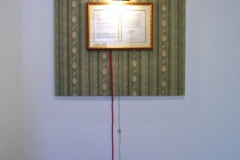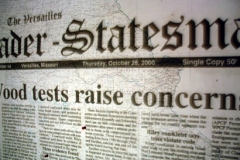Enduring freedom V.3 | 2003
Enduring freedom v.3 – produced for YouGenics an exhibition exploring the social implications of biotechnology. Curator – Ryan Griffis.
Materials: Wall paper, Lamp, Framed document – Biotechnology Industry Organization (BIO)letter to George W. Bush showing support for the “war on terror” and outlining the Biotech industry’s political/economic agenda for 2002.
Wall text – “When I was coming up it was a dangerous world, and you knew exactly who they were. It was us versus them, and you knew exactly who them was. Today, we are not so sure who they are, but we know they’re there” President GW Bush
Overhead projector – Projected newspaper article concerning the public outcry over the military spraying of biological agents at Fort Leonard Wood (90 miles from the site of the exhibition) as part of the current administration’s Project BioShield (supported by BIO).
Congressional records – Transcripts of congressional hearings concerning extensive secret testing of biological and chemical agents on the American public by the Department of Defense, the CIA and other agencies since the 1940’s.
Installation note: The various components of the installation are tied together with the use of red and green extension cords that run up walls and across ceilings to connect the power cords from both the overhead projector and lamp into a single electrical outlet (printed with an American flag motif). The access red and green cords are woven together, coiled and tied with camouflage fabric on the floor below the framed document display.
Comment: As with the study of any cultural representation, a good deal can be learned about a technology’s research and development by addressing the ideology of its patrons. The biotechnology industry and the current administration have expressed their political and economic alignment in the “war on terror” apparently by responding with their own form of terror. The US government’s experimentation with biological weapons is well documented, and so is the government’s commitment to contracting from and passing technologies to the private sector. A little research can begin to tell us what’s in store and who’s buying.













